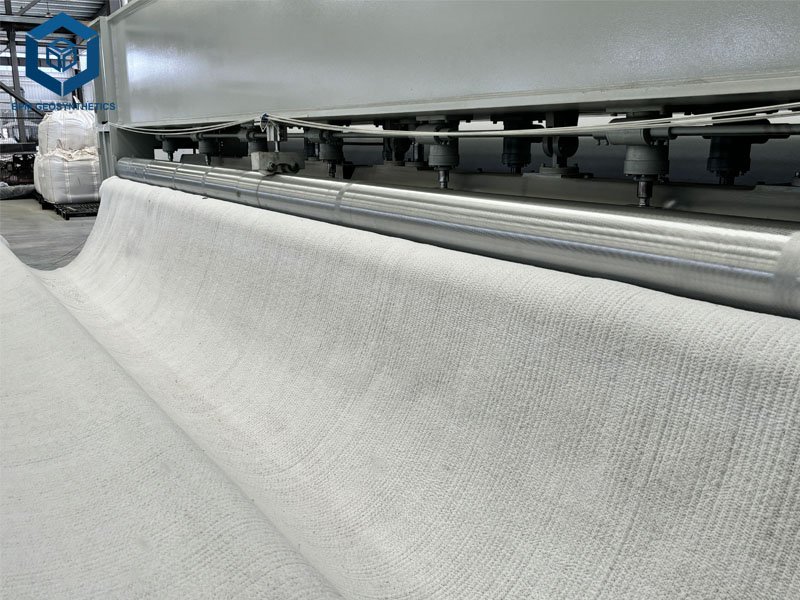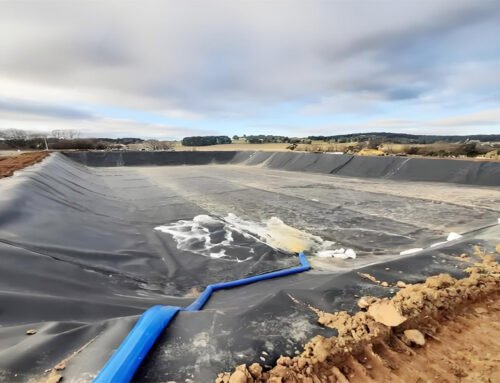Geosynthetic clay liners (GCLs) are widely used in civil engineering and environmental applications for containment purposes, such as landfill liners, pond liners, and secondary containment systems. Understanding the pricing of geosynthetic clay liner price is essential for project budgeting and decision-making. In this article, we will explore the factors influencing GEOSINCERE geosynthetic clay liners prices, recent trends in pricing, and provide a cost analysis based on specific examples.
The cost of a geosynthetic clay liner ranges from $1.50 to $5.00 per square foot, while the average cost of a geosynthetic clay liner system (including installation) ranges from $4 to $7 per square foot. However, the cost of a geosynthetic clay liner may not initially be the cheapest option at the outset, but it can provide long-term cost savings due to its durability and effectiveness in reducing seepage.
1. Factors Affecting the Price of Geosynthetic Clay Liners:
1.1 Geosynthetic Clay Liner Price – Raw Materials:
The cost of raw materials used in geosynthetic clay liners manufacturing, including bentonite, geotextiles, and polymer additives, significantly affects the overall price of geosynthetic clay liners. Fluctuations in the prices of these materials can affect geosynthetic clay liners pricing.
1.2 Geosynthetic Clay Liner Price – Manufacturing Process:
The complexity of the manufacturing process, quality control measures and technological advancements affect production costs and therefore geosynthetic clay liners prices.
1.3 Geosynthetic Clay Liner Price – Thickness and Gauges:
Geosynthetic clay liners is available in various thicknesses and gauges and can be tailored to specific project requirements. Thicker pads with higher performance specifications may command a higher price due to increased material and manufacturing costs.
1.4 Geosynthetic Clay Liner Price – Market Demand and Supply:
Supply and demand dynamics in the geosynthetics market, influenced by infrastructure development, environmental regulations and construction activities, may impact geosynthetic clay liners prices.
1.5 Geosynthetic Clay Liner Price – Transportation and Logistics:
Transportation costs (including transportation and handling) play a role in determining the final price of a geosynthetic clay liners, especially for projects located in remote or inaccessible areas.


2. Latest Trends in Geosynthetic Clay Liner Pricing:
According to industry reports and market analysis, geosynthetic clay liners pricing has experienced the following trends in recent years:
- Steady Growth: Overall, prices of geosynthetic clay liners have been rising steadily due to rising demand, inflationary pressures, and rising raw material and manufacturing costs.
- Technological Advances: Investments in R&D have led to the introduction of advanced geosynthetic clay liners formulations with enhanced performance characteristics. While these innovations offer improved functionality, they can come at a higher price.
- Market Competition: Increased competition among geosynthetic clay liners manufacturers has resulted in pricing pressure, with some suppliers offering competitive pricing strategies to gain market share.
These price ranges may vary based on specific project requirements, location, suppliers and market conditions.
Geosynthetic clay liners play a vital role in environmental containment applications. Their pricing can vary widely based on several factors. These include raw materials, manufacturing processes, specifications, market dynamics, and transportation costs. Understanding these factors and recent pricing trends is critical for project planning. It is also crucial for budgeting and purchasing decisions. Conducting a thorough cost analysis is essential. Evaluating various vendors helps optimize project outcomes and costs.
3. Outstanding advantages of geosynthetic clay liner:
- Permanent waterproofing is essential for various applications. Made of natural bentonite, it will not age and remains effective over time. This material is very environmentally friendly. It helps keep water clean and does not negatively impact aquatic plants and animals. Additionally, its use ensures long-term durability and performance in waterproofing projects.
- The permeability coefficient is extremely low, the permeability coefficient is only 10~9em/s. And the anti-seepage hydrostatic pressure can reach more than 1.0MPa.
- The construction is simple and not limited by the construction environment temperature, and can be constructed at minus 32~C.
- The construction is simple, just backfill after laying.
- Overlap laying can resist the uneven settlement of geology and frost heave.
- No special installation equipment is required.
- Geosynthetic clay liners has the characteristics of self-healing, easy repair, and not afraid of small sharp objects piercing. If the waterproof layer is damaged by accident, it only needs to be simply repaired. Reduce the annual maintenance project cost and reduce the project cost.
4. What Are The Applications Of Geosynthetic Clay Liners?
Geosynthetic clay liners (GCLs) are widely used in various industrial projects due to their excellent barrier properties, flexibility, and ease of installation. Here are some key applications:
4.1 Landfill Liners:
GCLs are commonly used as primary or secondary liners. They are employed in municipal solid waste landfills, hazardous waste disposal sites, and industrial landfills. These liners provide a robust barrier against contaminant migration. This prevents contaminants from entering the soil and groundwater. Additionally, GCLs are cost-effective and easy to install. They offer long-term durability and performance. Their use ensures environmental protection and regulatory compliance.
4.2 Mining Applications:
In the mining industry, GCLs are used for containment. They are used in tailings dams, leach pads, and other risky areas. Acid mine drainage or heavy metal leaching is a concern. GCLs help prevent environmental contamination from mining operations. Additionally, they offer cost-effective solutions for environmental protection. Their use ensures compliance with stringent environmental regulations.
4.3 Oil and Gas Industry:
GCLs are utilized in oil and gas drilling sites, storage tanks, and pipeline right-of-ways. They help prevent leaks and spills. Their adaptability to uneven surfaces makes them ideal for these applications. Additionally, GCLs offer long-term durability and performance. They ensure environmental protection and regulatory compliance.
4.4 Construction and Building Sites:
GCLs are often used under concrete slabs, basements, and foundations to act as moisture barriers. This helps in preventing water ingress and protecting the structural integrity of buildings.
4.5 Agricultural Projects:
In large-scale agricultural projects, GCLs can be used to line irrigation canals and ponds. They minimize seepage and ensure efficient water usage. Additionally, GCLs are cost-effective and environmentally friendly. They help conserve water resources in agriculture.
4.6 Environmental Remediation:
GCLs play a crucial role in environmental remediation projects. They are used for capping contaminated sites. They also line pits and ponds used for pollutant treatment and storage. Additionally, GCLs help prevent further soil and groundwater contamination. They ensure long-term environmental safety and compliance.
4.7 Road and Highway Construction:
GCLs are used in road embankments and highway construction. They prevent moisture infiltration, which can lead to soil erosion and instability. Additionally, GCLs offer long-term durability and performance. They ensure structural stability and safety of transportation infrastructure.
4.8 Water Containment Facilities:
For reservoirs, canals, and other water containment structures, GCLs provide an effective barrier. They prevent water loss through seepage. Additionally, they ensure the efficient management of water resources. This helps maintain structural integrity and safety.
4.9 Sewage Treatment Plants:
Geosynthetic clay liners (GCLs) play a crucial role in environmental protection. Specifically, they are employed in the lining of sewage treatment ponds and lagoons. This application is essential to prevent leakage of treated effluent back into the environment. Consequently, GCLs ensure that the treated water remains contained. This helps in safeguarding natural water bodies from contamination.
4.10 Industrial Ponds and Reservoirs:
In industrial settings, GCLs are utilized for lining ponds and reservoirs. These structures often store chemicals, process water, or other industrial fluids. By using GCLs, the risk of leakage is minimized. This ensures minimal environmental impact.


5. Conclusion
Geosynthetic clay liners are a new type of geosynthetics. They are made by filling sodium-based bentonite particles between woven and non-woven geotextiles. The upper layer’s non-woven fibers connect to the lower layer’s woven fabric through special processes. Bentonite particles in this waterproof blanket do not flow in one direction. This forms a uniform waterproof layer throughout. It is an excellent waterproof and anti-seepage material. It can be widely used in various construction conditions for waterproof and anti-seepage projects.
6. Choosing A Good Geosynthetic Clay Liners Supplier
Shandong Geosino New Material Co., Ltd (Brand: Geosincere) is a leading manufacturer and wholesaler of geosynthetic clay liners and other geosynthetics in Shandong Province, China. We specialize in producing HDPE pool liners, geotextiles, geogrids, geocells, drainage boards, and more.
Our products are exported to over 100 countries globally. GEOSINCERE continuously invests in technological innovation and manufacturing improvements. We have invested $10 million in our state-of-the-art factory, equipped with advanced automatic production lines.
These investments ensure the production of high-quality geosynthetics with optimized processes. Our extensive product line is renowned for its quality, performance, durability, and cost-effectiveness.
GEOSINCERE’s geosynthetic clay liners and other products meet customer requirements through solid technology and innovative solutions. We strive to address complex civil, mining, and environmental challenges with high-performance products.Our commitment to quality assurance, competitive factory prices, and fast delivery times highlights our competitive advantages.





